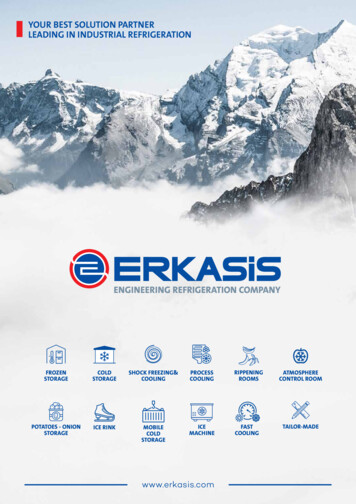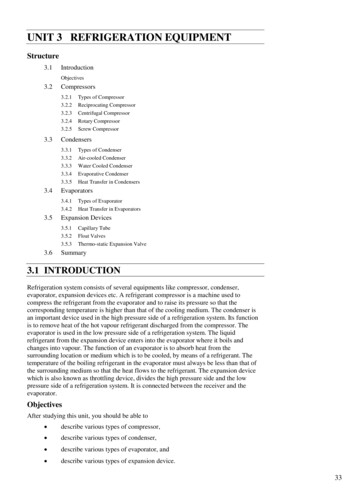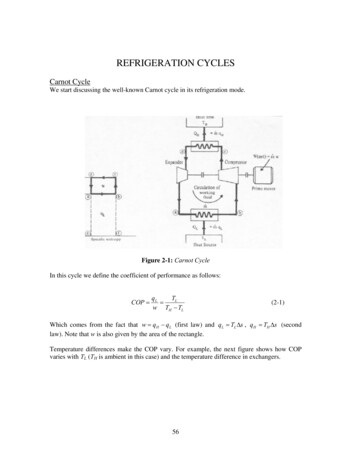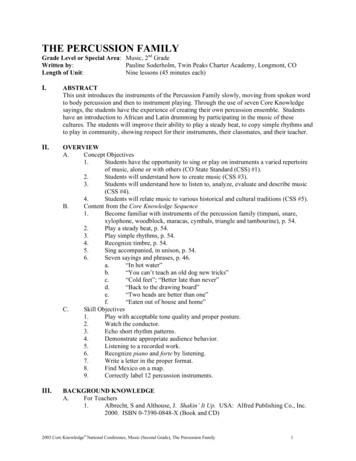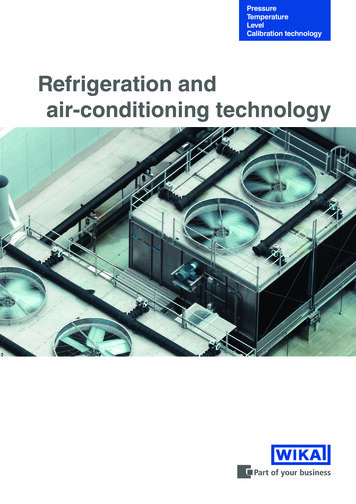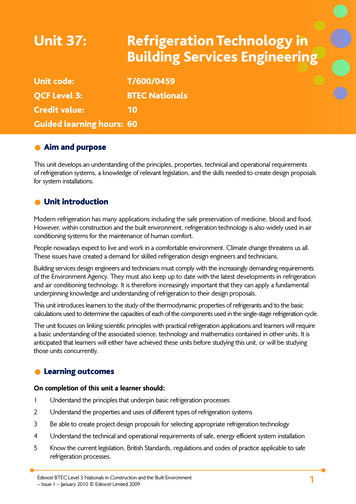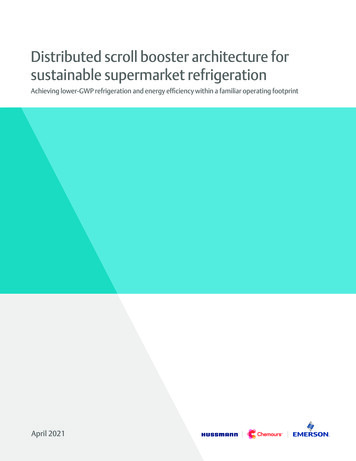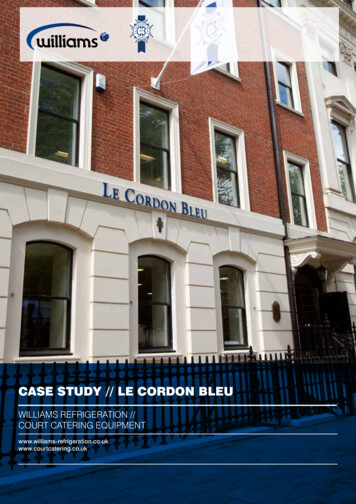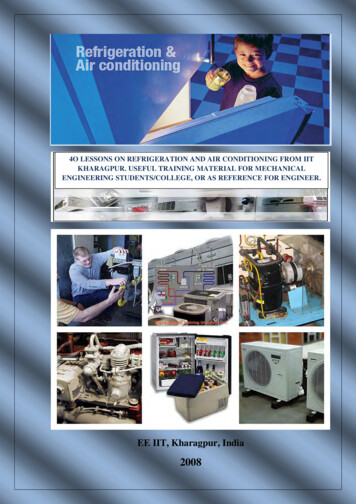
Transcription
4O LESSONS ON REFRIGERATION AND AIR CONDITIONING FROM IITKHARAGPUR. USEFUL TRAINING MATERIAL FOR MECHANICALENGINEERING STUDENTS/COLLEGE, OR AS REFERENCE FOR ENGINEER.EE IIT, Kharagpur, India2008
Contents:LessonLesson 1 History Of Refrigeration [Natural Refrigeration ArtificialRefrigeration ]Lesson 2 History Of Refrigeration - Development Of Refrigerants AndCompressors [ Refrigerant development - a brief history CompressorPage726development - a brief history ]Lesson 3 Applications Of Refrigeration & Air Conditioning [ Application ofrefrigeration in Food processing, preservation and distribution Applications ofrefrigeration in chemical and process industries Special applications of refrigeration Application of air conditioning ]Lesson 4 Review of fundamental principles - Thermodynamics : Part I [Definitions Thermodynamic properties Fundamental laws of Thermodynamics ]Lesson 5 Review of fundamental principles - Thermodynamics : Part II [Thermodynamic relations Evaluation of thermodynamic properties Thermodynamic processes ]Lesson 6 Review of fundamentals: Fluid flow [ Fluid flow ]Lesson 7 Review of fundamentals: Heat and Mass transfer [ Heat transfer Fundamentals of Mass transfer Analogy between heat, mass and momentumtransfer Multimode heat transfer Heat exchangers ]Lesson 8 Methods of producing Low Temperatures [ Sensible cooling by coldmedium Endothermic mixing of substances Phase change processes Expansionof Liquids Expansion of gases Thermoelectric Refrigeration Adiabaticdemagnetization ]Lesson 9 Air cycle refrigeration systems [ Air Standard Cycle analysis Basicconcepts Reversed Carnot cycle employing a gas Ideal reverse Brayton cycle Aircraft cooling systems ]44647893104124138
Lesson 10 Vapour Compression Refrigeration Systems [ Comparisonbetween gas cycles and vapor cycles Vapour Compression Refrigeration Systems The Carnot refrigeration cycle Standard Vapour Compression Refrigeration System(VCRS) Analysis of standard vapour compression refrigeration system ]Lesson 11 Vapour Compression Refrigeration Systems: PerformanceAspects And Cycle Modifications [ Performance of SSS cycle Modifications to153171SSS cycle Effect of superheat on system COP Actual VCRS systems Completevapour compression refrigeration systems ]Lesson 12 Multi-Stage Vapour Compression Refrigeration Systems [ Flashgas removal using flash tank Intercooling in multi-stage compression Multi-stagesystem with flash gas removal and intercooling Use of flash tank for flash gasremoval Use of flash tank for intercooling only ]Lesson 13 Multi-Evaporator And Cascade Systems [ Individual evaporatorsand a single compressor with a pressure-reducing valve Multi-evaporator systemwith multi-compression, intercooling and flash gas removal Multi-evaporatorsystem with individual compressors and multiple expansion valves Limitations ofmulti-stage systems Cascade Systems ]Lesson 14 Vapour Absorption Refrigeration Systems [ Maximum COP of idealabsorption refrigeration system Properties of refrigerant-absorbent mixtures Basic Vapour Absorption Refrigeration System Refrigerant-absorbent combinationsfor VARS ]Lesson 15 Vapour Absorption Refrigeration Systems Based On WaterLithium Bromide Pair [ Properties of water-lithium bromide solutions Steady193213238258flow analysis of Water-Lithium Bromide Systems Practical problems in waterlithium bromide systems Commercial systems Heat sources for water-lithiumbromide systems Minimum heat source temperatures for LiBr-Water systems Capacity control ]Lesson 16 Vapour Absorption Refrigeration Systems Based On AmmoniaWater Pair [ Properties of ammonia-water solutions Basic Steady-Flow Processes279with binary mixtures ]Lesson 17 Vapour Absorption Refrigeration Systems Based On AmmoniaWater Pair [ Working principle Principle of rectification column and dephlegmator Steady-flow analysis of the system Pumpless vapour absorption refrigerationsystems Solar energy driven sorption systems Comparison between compressionand absorption refrigeration systems ]301
Lesson 18 Refrigeration System Components: Compressors [ Compressors Reciprocating compressors ]Lesson 19 Performance Of Reciprocating Compressors [ Ideal compressorwith clearance Actual compression process Capacity control of reciprocatingcompressors Compressor lubrication ]Lesson 20 Rotary, Positive Displacement Type Compressors [ Rolling piston(fixed vane) type compressors Multiple vane type compressors Characteristics ofrotary, vane type compressors Rotary, screw compressors Scroll compressors ]Lesson 21 Centrifugal Compressors [ Analysis of centrifugal compressors Selection of impeller Speed and impeller diameter Refrigerant capacity ofcentrifugal compressors Performance aspects of centrifugal compressor Commercial refrigeration systems with centrifugal compressors ]Lesson 22 Condensers & Evaporators [ Condensers Classification ofcondensers Analysis of condensers Optimum condenser pressure for lowestrunning cost ]Lesson 23 Condensers & Evaporators [ Classification Natural Convection typeevaporator coils Flooded Evaporator Shell-and-Tube Liquid Chillers Shell-andCoil type evaporator Double pipe type evaporator Baudelot type evaporators Direct expansion fin-and-tube type Plate Surface Evaporators Plate typeevaporators Thermal design of evaporators Enhancement of heat transfercoefficients Wilson's plot ]Lesson 24 Expansion Devices [ Capillary Tube Automatic Expansion Valve (AEV) Flow Rate through orifice Thermostatic Expansion Valve (TEV) Float typeexpansion valves Electronic Type Expansion Valve Practical problems in operationof Expansion valves ]Lesson 25 Analysis Of Complete Vapour Compression RefrigerationSystems [ Reciprocating compressor performance characteristics Evaporator317337361376402439465504Performance Expansion valve Characteristics Condensing unit Performance ofcomplete system - condensing unit and evaporator Effect of expansion valve ]Lesson 26 Refrigerants [ Primary and secondary refrigerants Refrigerantselection criteria Designation of refrigerants Comparison between differentrefrigerants ]523
Lesson 27 Psychrometry [ Methods for estimating properties of moist air Measurement of psychrometric properties Calculation of psychrometric propertiesfrom p, DBT and WBT Psychrometer ]Lesson 28 Psychrometric Processes [ Important psychrometric processes AirWashers Enthalpy potential ]Lesson 29 Inside And Outside Design Conditions [ Selection of inside designconditions Thermal comfort Heat balance equation for a human being Factorsaffecting thermal comfort Indices for thermal comfort Predicted Mean Vote(PMV) and Percent People Dissatisfied (PPD) Selection of outside design conditions]Lesson 30 Psychrometry Of Air Conditioning Systems [ Summer airconditioning systems Guidelines for selection of supply state and cooling coil ]Lesson 31 Evaporative, Winter And All Year Air Conditioning Systems [Introduction to evaporative air conditioning systems Classification of evaporativecooling systems Advantages and disadvantages of evaporative cooling systems Applicability of evaporative cooling systems Winter Air Conditioning Systems Allyear (complete) air conditioning systems ]537553572591608Lesson 32 Cooling And Heating Load Calculations - Estimation Of SolarRadiation [ Solar radiation Calculation of direct, diffuse and reflected radiations ]626Lesson 33 Cooling And Heating Load Calculations -Solar RadiationThrough Fenestration - Ventilation And Infiltration [ Solar radiation through645fenestration Estimation of solar radiation through fenestration Effect of externalshading Ventilation for Indoor Air Quality (IAQ) Infiltration Heating and coolingloads due to ventilation and infiltration ]Lesson 34 Cooling And Heating Load Calculations - Heat Transfer ThroughBuildings - Fabric Heat Gain/Loss [ One-dimensional, steady state heat transfer660through buildings Unsteady heat transfer through opaque walls and roofs Onedimensional, unsteady heat transfer through building walls and roof ]Lesson 35 Cooling And Heating Load Calculations - Estimation OfRequired Cooling/Heating Capacity [ Heating versus cooling load calculations Methods of estimating cooling and heating loads Cooling load calculations Estimation of the cooling capacity of the system Heating load calculations ]688
Lesson 36 Selection Of Air Conditioning Systems [ Selection criteria for airconditioning systems Classification of air conditioning systems All water systems Air-water systems Unitary refrigerant based systems ]Lesson 37 Transmission Of Air In Air Conditioning Ducts [ Transmission of air Flow of air through ducts Estimation of pressure loss in ducts Dynamic losses inducts Static Regain ]Lesson 38 Design Of Air Conditioning Ducts [ General rules for duct design Classification of duct systems Commonly used duct design methods Performanceof duct systems System balancing and optimization Fans ]Lesson 39 Space Air Distribution [ Design of air distribution systems Behaviourof free-stream jet Circular jets Types of air distribution devices Return air inlets Airflow patterns inside conditioned space Stratified mixing flow Spotcooling/heating Selection of supply air outlets ]Lesson 40 Ventilation For Cooling [ Natural versus mechanical ventilation Natural ventilation Guidelines for natural ventilation Forced ventilation usingelectric fans Interior air movement ]Reference books for this course709734752772797809
Lesson1History Of Refrigeration1Version 1 ME, IIT Kharagpur
Objectives of the lesson:The objectives of this lesson are to:1. Define refrigeration and air conditioning (Section 1.1)2. Introduce aspects of various natural refrigeration methods, namely:a.b.c.d.e.Use of ice transported from colder regions (Section 1.2)Use of ice harvested in winter and stored in ice houses (Section 1.2)Use of ice produced by nocturnal cooling (Section 1.2.1)Use of evaporative cooling (Section 1.2.2)Cooling by salt solutions (Section 1.2.3)3. Introduce historical aspects of various artificial refrigeration methods, namely:a. Vapour compression refrigeration systems, includingi. Domestic refrigeration systems (Section 1.3.1.1)ii. Air conditioning systems (Section 1.3.1.2)b. Vapour absorption refrigeration systems (Section 1.3.2)c. Solar energy based refrigeration systems (Section 1.3.3)d. Air cycle refrigeration systems (Section 1.3.4)e. Steam and vapor jet refrigeration systems (Section 1.3.5)f. Thermoelectric refrigeration systems (Section 1.3.6), andg. Vortex tubes (Section 1.3.7)At the end of the lesson the student should be able to:1. Identify various natural and artificial methods of refrigeration2. List salient points of various refrigeration techniques, and3. Name important landmarks in the history of refrigeration1.1. IntroductionRefrigeration may be defined as the process of achieving and maintaining atemperature below that of the surroundings, the aim being to cool some product or space tothe required temperature. One of the most important applications of refrigeration has been thepreservation of perishable food products by storing them at low temperatures. Refrigerationsystems are also used extensively for providing thermal comfort to human beings by meansof air conditioning. Air Conditioning refers to the treatment of air so as to simultaneouslycontrol its temperature, moisture content, cleanliness, odour and circulation, as required byoccupants, a process, or products in the space. The subject of refrigeration and airconditioning has evolved out of human need for food and comfort, and its history dates backto centuries. The history of refrigeration is very interesting since every aspect of it, theavailability of refrigerants, the prime movers and the developments in compressors and themethods of refrigeration all are a part of it. The French scientist Roger ThÝvenot has writtenan excellent book on the history of refrigeration throughout the world. Here we present only a2Version 1 ME, IIT Kharagpur
brief history of the subject with special mention of the pioneers in the field and someimportant events.Q: Which of the following can be called as a refrigeration process?a) Cooling of hot ingot from 1000oC to room temperatureb) Cooling of a pot of water by mixing it with a large block of icec) Cooling of human beings using a ceiling fand) Cooling of a hot cup of coffee by leaving it on a tablee) Cooling of hot water by mixing it with tap waterf) Cooling of water by creating vacuum over itAns: b) and f)1.2. Natural RefrigerationIn olden days refrigeration was achieved by natural means such as the use of ice orevaporative cooling. In earlier times, ice was either:1. Transported from colder regions,2. Harvested in winter and stored in ice houses for summer use or,3. Made during night by cooling of water by radiation to stratosphere.In Europe, America and Iran a number of icehouses were built to store ice. Materialslike sawdust or wood shavings were used as insulating materials in these icehouses. Later on,cork was used as insulating material. Literature reveals that ice has always been available toaristocracy who could afford it. In India, the Mogul emperors were very fond of ice duringthe harsh summer in Delhi and Agra, and it appears that the ice used to be made by nocturnalcooling.In 1806, Frederic Tudor, (who was later called as the “ice king”) began the trade inice by cutting it from the Hudson River and ponds of Massachusetts and exporting it tovarious countries including India. In India Tudor’s ice was cheaper than the locallymanufactured ice by nocturnal cooling. The ice trade in North America was a flourishingbusiness. Ice was transported to southern states of America in train compartments insulatedby 0.3m of cork insulation. Trading in ice was also popular in several other countries such asGreat Britain, Russia, Canada, Norway and France. In these countries ice was eithertransported from colder regions or was harvested in winter and stored in icehouses for use insummer. The ice trade reached its peak in 1872 when America alone exported 225000 tonnesof ice to various countries as far as China and Australia. However, with the advent ofartificial refrigeration the ice trade gradually declined.1.2.1. Art of Ice making by Nocturnal Cooling:The art of making ice by nocturnal cooling was perfected in India. In this method icewas made by keeping a thin layer of water in a shallow earthen tray, and then exposing thetray to the night sky. Compacted hay of about 0.3 m thickness was used as insulation. Thewater looses heat by radiation to the stratosphere, which is at around -55 C and by earlymorning hours the water in the trays freezes to ice. This method of ice production was verypopular in India.3Version 1 ME, IIT Kharagpur
1.2.2. Evaporative Cooling:As the name indicates, evaporative cooling is the process of reducing the temperatureof a system by evaporation of water. Human beings perspire and dissipate their metabolicheat by evaporative cooling if the ambient temperature is more than skin temperature.Animals such as the hippopotamus and buffalo coat themselves with mud for evaporativecooling. Evaporative cooling has been used in India for centuries to obtain cold water insummer by storing the water in earthen pots. The water permeates through the pores ofearthen vessel to its outer surface where it evaporates to the surrounding, absorbing its latentheat in part from the vessel, which cools the water. It is said that Patliputra Universitysituated on the bank of river Ganges used to induce the evaporative-cooled air from the river.Suitably located chimneys in the rooms augmented the upward flow of warm air, which wasreplaced by cool air. Evaporative cooling by placing wet straw mats on the windows is alsovery common in India. The straw mat made from “khus” adds its inherent perfume also to theair. Now-a-days desert coolers are being used in hot and dry areas to provide cooling insummer.1.2.3. Cooling by Salt Solutions:Certain substances such as common salt, when added to water dissolve in water andabsorb its heat of solution from water (endothermic process). This reduces the temperature ofthe solution (water salt). Sodium Chloride salt (NaCl) can yield temperatures up to -20 Cand Calcium Chloride (CaCl2) up to - 50 C in properly insulated containers. However, as it isthis process has limited application, as the dissolved salt has to be recovered from its solutionby heating.Q. The disadvantages of natural refrigeration methods are:a) They are expensiveb) They are uncertainc) They are not environment friendlyd) They are dependent on local conditionsAns: b) and d)Q. Evaporative cooling systems are ideal for:a) Hot and dry conditionsb) Hot and humid conditionsc) Cold and humid conditionsd) Moderately hot but humid conditionsAns: a)4Version 1 ME, IIT Kharagpur
1.3. Artificial RefrigerationRefrigeration as it is known these days is produced by artificial means. Though it isvery difficult to make a clear demarcation between natural and artificial refrigeration, it isgenerally agreed that the history of artificial refrigeration began in the year 1755, when theScottish professor William Cullen made the first refrigerating machine, which could producea small quantity of ice in the laboratory. Based on the working principle, refrigerationsystems can be classified as vapour compression systems, vapour absorption systems, gascycle systems etc.1.3.1. Vapour Compression Refrigeration Systems:The basis of modern refrigeration is the ability of liquids to absorb enormousquantities of heat as they boil and evaporate. Professor William Cullen of the University ofEdinburgh demonstrated this in 1755 by placing some water in thermal contact with etherunder a receiver of a vacuum pump. The evaporation rate of ether increased due to thevacuum pump and water could be frozen. This process involves two thermodynamicconcepts, the vapour pressure and the latent heat. A liquid is in thermal equilibrium with itsown vapor at a pressure called the saturation pressure, which depends on the temperaturealone. If the pressure is increased for example in a pressure cooker, the water boils at highertemperature. The second concept is that the evaporation of liquid requires latent heat duringevaporation. If latent heat is extracted from the liquid, the liquid gets cooled. The temperatureof ether will remain constant as long as the vacuum pump maintains a pressure equal tosaturation pressure at the desired temperature. This requires the removal of all the vaporsformed due to vaporization. If a lower temperature is desired, then a lower saturation pressurewill have to be maintained by the vacuum pump. The component of the modern dayrefrigeration system where cooling is produced by this method is called evaporator.If this process of cooling is to be made continuous the vapors have to be recycled bycondensation to the liquid state. The condensation process requires heat rejection to thesurroundings. It can be condensed at atmospheric temperature by increasing its pressure. Theprocess of condensation was learned in the second half of eighteenth century. U.F. Clouet andG. Monge liquefied SO2 in 1780 while van Marum and Van Troostwijk liquefied NH3 in1787. Hence, a compressor is required to maintain a high pressure so that the evaporatingvapours can condense at a temperature greater than that of the surroundings.Oliver Evans in his book “Abortion of a young Steam Engineer’s Guide” published inPhiladelphia in 1805 described a closed refrigeration cycle to produce ice by ether undervacuum. Jacob Perkins, an American living in London actually designed such a systemin1835. The apparatus described by Jacob Perkins in his patent specifications of 1834 isshown in Fig.1.1. In his patent he stated “I am enabled to use volatile fluids for the purpose ofproducing the cooling or freezing of fluids, and yet at the same time constantly condensingsuch volatile fluids, and bringing them again into operation without waste”.5Version 1 ME, IIT Kharagpur
Fig. 1.1. Apparatus described by Jacob Perkins in his patent specification of 1834.The refrigerant (ether or other volatile fluid) boils in evaporator B taking heat fromsurrounding water in container A. The pump C draws vapour away and compresses itto higher pressure at which it can condense to liquids in tubes D, giving out heat towater in vessel E. Condensed liquid flows through the weight loaded valve H, whichmaintains the difference of pressure between the condenser and evaporator. The smallpump above H is used for charging the apparatus with refrigerant.John Hague made Perkins’s design into working model with some modifications. ThisPerkins machine is shown in Fig.1.2. The earliest vapour compression system used eithersulphuric (ethyl) or methyl ether. The American engineer Alexander Twining (1801-1884)received a British patent in 1850 for a vapour compression system by use of ether, NH3 andCO2.The man responsible for making a practical vapor compression refrigeration systemwas James Harrison who took a patent in 1856 for a vapour compression system using ether,alcohol or ammonia. Charles Tellier of France patented in 1864, a refrigeration system usingdimethyl ether which has a normal boiling point of 23.6 C.6Version 1 ME, IIT Kharagpur
Fig.1.2. Perkins machine built by John HagueCarl von Linde in Munich introduced double acting ammonia compressor. It requiredpressures of more than 10 atmospheres in the condenser. Since the normal boiling point ofammonia is -33.3 C, vacuum was not required on the low pressure side. Since then ammoniais used widely in large refrigeration plants.David Boyle, in fact made the first NH3 system in 1871 in San Francisco. JohnEnright had also developed a similar system in 1876 in Buffalo N.Y. Franz Windhausendeveloped carbon dioxide (CO2) based vapor compression system in Germany in 1886. Thecarbon dioxide compressor requires a pressure of about 80 atmospheres and therefore a veryheavy construction. Linde in 1882 and T.S.C. Lowe in 1887 tried similar systems in USA.The CO2 system is a very safe system and was used in ship refrigeration until 1960s. RaoulPictet used SO2 (NBP -10 C) as refrigerant. Its lowest pressure was high enough to preventthe leakage of air into the system.Palmer used C2H5Cl in 1890 in a rotary compressor. He mixed it with C2H5Br toreduce its flammability. Edmund Copeland and Harry Edwards used iso-butane in 1920 insmall refrigerators. It disappeared by 1930 when it was replaced by CH3Cl. Dichloroethylene(Dielene or Dieline) was used by Carrier in centrifugal compressors in 1922-26.1.3.1.1. Domestic refrigeration systems:The domestic refrigerator using natural ice (domestic ice box) was invented in 1803and was used for almost 150 years without much alteration. The domestic ice box used to bemade of wood with suitable insulation. Ice used to be kept at the top of the box, and lowtemperatures are produced in the box due to heat transfer from ice by natural convection. Adrip pan is used to collect the water formed due to the melting of ice. The box has to bereplenished with fresh ice once all the ice melts. Though the concept is quite simple, thedomestic ice box suffered from several disadvantages. The user has to replenish the ice as7Version 1 ME, IIT Kharagpur
soon as it is consumed, and the lowest temperatures that could be produced inside thecompartment are limited. In addition, it appears that warm winters caused severe shortage ofnatural ice in USA. Hence, efforts, starting from 1887 have been made to develop domesticrefrigerators using mechanical systems. The initial domestic mechanical refrigerators werecostly, not completely automatic and were not very reliable. However, the development ofmechanical household refrigerators on a large scale was made possible by the development ofsmall compressors, automatic refrigerant controls, better shaft seals, developments inelectrical power systems and induction motors. General Electric Company introduced the firstdomestic refrigerator in 1911, followed by Frigidaire in 1915. Kelvinator launched thedomestic mechanical refrigerator in 1918 in USA. In 1925, USA had about 25 milliondomestic refrigerators of which only 75000 were mechanical. However, the manufacture ofdomestic refrigerators grew very rapidly, and by 1949 about 7 million domestic refrigeratorswere produced annually. With the production volumes increasing the price fell sharply (theprice was 600 dollars in 1920 and 155 dollars in 1940). The initial domestic refrigerators usedmainly sulphur dioxide as refrigerant. Some units used methyl chloride and methylenechloride. These refrigerants were replaced by Freon-12 in 1930s. In the beginning theserefrigerators were equipped with open type compressors driven by belt drive. GeneralElectric Company introduced the first refrigerator with a hermetic compressor in 1926. Soonthe open type compressors were completely replaced by the hermetic compressors. Firstrefrigerators used water-cooled condensers, which were soon replaced by air cooledcondensers. Though the development of mechanical domestic refrigerators was very rapid inUSA, it was still rarely used in other countries. In 1930 only rich families used domesticrefrigerators in Europe. The domestic refrigerator based on absorption principle as proposedby Platen and Munters, was first made by Electrolux Company in 1931 in Sweden. In Japanthe first mechanical domestic refrigerator was made in 1924. The first dual temperature(freezer-refrigerator) domestic refrigerator was introduced in 1939. The use of mechanicaldomestic refrigerators grew rapidly all over the world after the Second World War. Today, adomestic refrigerator has become an essential kitchen appliance not only in highly developedcountries but also in countries such as India. Except very few almost all the present daydomestic refrigerators are mechanical refrigerators that use a hermetic compressor and an aircooled condenser. The modern refrigerators use either HFC-134a (hydro-fluoro-carbon) oriso-butane as refrigerant.1.3.1.2. Air conditioning systems:Refrigeration systems are also used for providing cooling and dehumidification insummer for personal comfort (air conditioning). The first air conditioning systems were usedfor industrial as well as comfort air conditioning. Eastman Kodak installed the first airconditioning system in 1891 in Rochester, New York for the storage of photographic films.An air conditioning system was installed in a printing press in 1902 and in a telephoneexchange in Hamburg in 1904. Many systems were installed in tobacco and textile factoriesaround 1900. The first domestic air conditioning system was installed in a house in Frankfurtin 1894. A private library in St Louis, USA was air conditioned in 1895, and a casino was airconditioned in Monte Carlo in 1901. Efforts have also been made to air condition passengerrail coaches using ice. The widespread development of air conditioning is attributed to theAmerican scientist and industrialist Willis Carrier. Carrier studied the control of humidity in1902 and designed a central air conditioning plant using air washer in 1904. Due to thepioneering efforts of Carrier and also due to simultaneous development of differentcomponents and controls, air conditioning quickly became very popular, especially after1923. At present comfort air conditioning is widely used in residences, offices, commercialbuildings, air ports, hospitals and in mobile applications such as rail coaches, automobiles,8Version 1 ME, IIT Kharagpur
aircrafts etc. Industrial air conditioning is largely responsible for the growth of modernelectronic, pharmaceutical, chemical industries etc. Most of the present day air conditioningsystems use either a vapour compression refrigeration system or a vapour absorptionrefrigeration system. The capacities vary from few kilowatts to megawatts.Figure 1.3 shows the basic components of a vapour compression refrigeration system.As shown in the figure the basic system consists of an evaporator, compressor, condenser andan expansion valve. The refrigeration effect is obtained in the cold region as heat is extractedby the vaporization of refrigerant in the evaporator. The refrigerant vapour from theevaporator is compressed in the compressor to a high pressure at which its saturationtemperature is greater than the ambient or any other heat sink. Hence when the high pressure,high temperature refrigerant flows through the condenser, condensation of the vapour intoliquid takes place by heat rejection to the heat sink. To complete the cycle, the high pressureliquid is made to flow through an expansion valve. In the expansion valve the pressure andtemperature of the refrigerant decrease. This low pressure and low temperature refrigerantvapour evaporates in the evaporator taking heat from the cold region. It should be observedthat the system operates on a closed cycle. The system requires input in the form ofmechanical work. It extracts heat from a cold space and rejects heat to a high temperatureheat sink.Fig.1.3. Schematic of a basic vapour compression refrigeration systemA refrigeration system can also be used as a heat pump, in which the useful output isthe high temperature heat rejected at the condenser. Alternatively, a refrigeration system canbe used for providing cooling in summer and heating in winter. Such systems have been builtand are available now.9Version 1 ME, IIT Kharagpur
Q. Compared to natural refrigeration methods, artificial refrigeration methods are:a) Continuousb) Reliablec) Environment friendlyd) Can work under almost all conditionsAns. a), b) and d)Q. In the evaporator of a vapour compression refrigeration system:a) A l
Lesson 30 Psychrometry Of Air Conditioning Systems [ Summer air conditioning systems Guidelines for selection of supply state and cooling coil ] 591 Lesson 31 Evaporative, Winter And All Year Air Conditioning Systems [ Introduction to evaporative air conditioning systems Classification of evaporative



